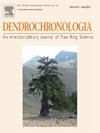不同气候条件下混交林和单一林分欧洲落叶松、挪威云杉和欧洲山毛榉木材解剖结构的比较分析
IF 2.7
3区 农林科学
Q1 FORESTRY
引用次数: 0
摘要
我们提出了一个树木年轮和木材解剖研究较少分布的欧洲落叶松(L. decidua)生长在混合单一的森林与经济上重要的挪威云杉(P. abies)和欧洲山毛榉(F. sylvatica)在相同的气象条件下在捷克高地。通过比较两个对照期:对照期(2009-2010年)和干旱期(2017-2018年)来评估树木对干旱的响应。我们分析了树木年轮宽度(TRW)、早期和晚期木材宽度(EWW/LWW)、管腔面积(LA)、细胞壁厚度(CWT)、细胞密度(CD)、相对传导面积(RCTA)、水力加权平均细胞直径(Dh)和潜在的水力传导率(Kp)。在干旱期,径向生长显著降低(51.8 %),其中云杉和山毛榉在单一栽培中下降最大,而落叶松的变化不显著。虽然混合栽培和单一栽培在种内的TRW差异不显著,但在木材解剖水平上存在显著差异。在干燥条件下,混合林分树种的解剖变异性普遍降低,水分传导性更稳定。然而,干旱的影响在较大的树木和密度较大的林分中更为明显,这表明森林结构可以放大对水分胁迫的脆弱性。物种特异性的干旱响应是明显的:落叶松没有解剖变化;云杉晚木的管腔面积和细胞壁厚度减少幅度最大;山毛榉减少了管腔面积,增加了细胞密度,提高了长期干旱条件下的水分输送效率。本文章由计算机程序翻译,如有差异,请以英文原文为准。
Comparative analysis of wood anatomy of European larch, Norway spruce, and European beech in mixed and monoculture stands under contrasting climatic conditions
We present a tree-ring and wood-anatomical study of less widespread European larch (L. decidua) growing in mixed a monoculture stands with the economically important Norway spruce (P. abies) and European beech (F. sylvatica) under identical meteorological conditions in the Czech highlands. Tree responses to drought were assessed by comparing two contrasting periods: Control period (2009–2010) and a Dry period (2017–2018). We analysed tree-ring widths (TRW), early- and latewood widths (EWW/LWW), lumen area (LA), cell wall thickness (CWT), cell density (CD), relative conducting area (RCTA), hydraulically weighted mean cell diameter (Dh), and the potential hydraulic conductivity (Kp). A significant reduction in radial growth (51.8 %) was observed during the Dry period, with spruce and beech showing the greatest decline in monocultures, while larch exhibited mostly non-significant changes. Although TRW did not differ significantly between mixtures and monocultures within species, notable variations emerged at the wood-anatomical level. Tree species generally showed reduced anatomical variability and more stable water conductivity mostly in mixed stands under dry conditions. However, drought impacts were more pronounced in larger trees and denser stands, suggesting that forest structure can amplify vulnerability to water stress. Species-specific drought responses were distinct: larch showed no anatomical changes; spruce exhibited the greatest reduction in latewood lumen area and cell wall thickness; and beech reduced lumen area while increasing cell density, enhancing water transport efficiency under prolonged drought.
求助全文
通过发布文献求助,成功后即可免费获取论文全文。
去求助
来源期刊

Dendrochronologia
FORESTRY-GEOGRAPHY, PHYSICAL
CiteScore
5.50
自引率
13.30%
发文量
82
审稿时长
22.8 weeks
期刊介绍:
Dendrochronologia is a peer-reviewed international scholarly journal that presents high-quality research related to growth rings of woody plants, i.e., trees and shrubs, and the application of tree-ring studies.
The areas covered by the journal include, but are not limited to:
Archaeology
Botany
Climatology
Ecology
Forestry
Geology
Hydrology
Original research articles, reviews, communications, technical notes and personal notes are considered for publication.
 求助内容:
求助内容: 应助结果提醒方式:
应助结果提醒方式:


